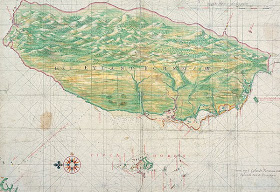It was in one of these armed conflicts, 500 藤牌兵 from Taiwan were recalled and sent to northern China to join in the fight. The order came directly from Emperor 康熙Kang-xi himself; although the suggestion most likely was put forth by a Han Chinese [Shi Lang?] The intrigued Emperor summoned an aging 林興珠Lin Hsing-Ju for a demonstration of the fighting strategy and skills of the 藤牌兵. Lin had served in Koxiga's military and twice surrendered to Qing as a faithful follower of his two previous commanders. 康熙 was suitably impressed by Lin's performance and an order to activate the infantrymen from Taiwan was issued.
On June 23, 1685, 彭春Pengcum led 3,000 Qing soldiers in an attack on 雅克薩Albazin. First Peng read to the Russian defenders Emperor 康熙's edict demanding their surrender. Then the Qing army laid siege to Albazin and blocked the access of the Russian artillerymen to their guns inside the fort. Two days later, a Russian reinforcement unit sailed east on the Amur黑龍江 on board of wooden rafts to reach Albazin. They were intercepted by the 藤牌兵 submerged in the river covered under their round rattan shields. The Russians panicked at the sight of soldiers with "huge hats" who came out of water to chop off their feet. Half of the Russian men were killed. The siege ended very quickly when the Qing soldiers set fire to the walls of Albazin. During the negotiations for surrender, >600 (almost all) of the Russians requested permission to go back to Nerchinsk. 康熙 received the news of the victory on July 5, 1685, while visiting his ancestral land in Manchuria. The Qing army and the Taiwanese soldiers then returned triumphantly to 璦琿. However, shortly after, on Aug 27, the Russians came back to harvest the crops and to brazenly re-build Albazin. In 1686, 2,000 Qing soldiers and 100 藤牌兵 were again dispatched to re-take the fort. In both campaigns, the 藤牌兵 suffered no casualties which was probably not what the scheming Han Chinese had anticipated.
What followed was a mystery. There was no mention in any official history of the 藤牌兵's safe return to their farming settlements. Some suggested that they were simply murdered by the Qing to totally wipe out the last remnants of the Ming-Cheng military. This does not seem likely because in 1696, 林興珠 and his men went on another campaign to fight against Mongolian rebels. He was well-rewarded and putatively died of old age in Beijing. In fact, a secret directive from 康熙 was to treat these infantrymen from Taiwan nicely.
There are other unofficial versions as far as the fate of the 500:
Version one: They settled in 齊齊哈爾Qiqihar in 黑龍江 Province.
According to 魏毓蘭's 《龍城舊聞》:“水師營兵,皆調自福建。今道署附近之土著,其先世皆福建人。若莆田林姓、同安陳姓,在福建本巨族,徙塞上仍大姓也。雅克薩之役,建義侯林興珠平羅剎,為閩人立功塞外之祖。故當日水師之權勢,雖不得比於滿洲,以視屯、站漢人,殊為優越。” This "Old Tales of the Dragon City" states that the soldiers of the Naval Camp in the city of Qiqihar all came from Hokkien. They were led by 林興珠 and had won the battle against the Russians at Abazin and were the ancestors of the natives now living near the Camp. They came with prominent Hokkien family names such as Lin of Pu-tien and Chen of Tung-An - now common local last names...
[Note: The info above was provided by a friend nicked-named Fishdoc.]
And Version two: They migrated to Cambodia.
According to 劉文海(?)'s 《西行奇見聞》:"曾聞安南西屬[即柬埔寨]有異人自海上入,劃地為界,乃不能制,[求]援於安南,[安南]王怪其無禮,遣軍擊之,異人手持墨棉 [即藤牌],兵刃不能損,以火觸之即燃。曾擒之,與其談,語不能通也,鏖戰經月,不可復制,安南國王遣使與談,約以[互]不[相]擾。因其為首者名「拎主[林興珠?]」故當地稱兩地之界為【拎邊】。" [Source: here] In other words, 林興珠 [拎主 appears a compressed 林興珠 when pronounced in Hokkien] and the 500 men [together with their families possibly totaling about 1,000] seemed to have escaped from China and ended up in the now Cambodia, then a client state of Viet Nam. According to this book, "Odd stories on the journey west", the King of Viet Nam came to the aid of Cambodia but was unable to defeat these "strangers" from overseas who were armed with sword-proof but inflammable rattan shields. It was also impossible to communicate with a captive/them who spoke a different language. The King, through an emissary, reached an agreement for both sides not to disturb each other and to keep within their own borders...
[Note: The author of Version two did admit that he had concocted the story.]
Often the unofficial stories contain grains of truth. It probably does not matter which version is more credible. Most important is that these 500 men seemed to have survived and had carried on unhindered as all Taiwanese would do in the face of great adversity.








